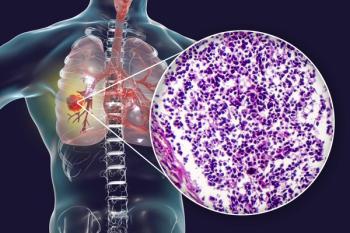
PFS Improves With Adagrasib Vs Chemo in KRAS+ NSCLC
A PFS benefit with adagrasib was observed across all key patient subgroups in the phase 3 KRYSTAL-12 trial.
Compared with docetaxel, adagrasib (Krazati) significantly and meaningfully improved progression-free survival (PFS) in those with advanced or metastatic non–small cell lung cancer (NSCLC) harboring a KRAS G12C mutation, according to data from the phase 3 KRYSTAL-12 trial (NCT04685135) presented at the
According to the primary analysis, overall response rate (ORR) also appeared significantly higher, with a more than doubled intracranial response rate among patients treated with adagrasib, compared with standard-of-care chemotherapy.
“Overall, [the] KRYSTAL-12 [trial] confirmed the role of adagrasib compared to docetaxel in terms of improvement of the progression-free survival, response rate and intracranial response such that it can be utilized in patients that harbor the KRASG12C mutation,” Tony S. K. Mok, MD, FRCPC, FASCO, The Chinese University of Hong Kong, said during a presentation of the data.
Statistical PFS
After a median follow-up of 9.4 months, patients treated with adagrasib demonstrated a median PFS of 5.5 months (95% CI, 4.5-6.7), compared with 3.8 months (95% CI, 2.7-4.7) with standard-of-care chemotherapy, reducing the risk for disease progression by 42% (HR, 0.58; 95% CI, 0.45-0.76; P < .0001).
Mok also highlighted that the 6-month PFS rates were 45%, compared with 30%, with adagrasib and docetaxel, respectively.
Further, PFS per investigator assessment was similar, with a median PFS of 5.4 months (95% CI, 4.6-6.9) with adagrasib, compared with 2.9 months (95% CI, 2.5-4.2) with docetaxel (HR, 0.57; 95% CI, 0.45-0.74).
Lastly, PFS benefit was observed across all key subgroups.
Tumor Responses
Patients treated with adagrasib demonstrated an ORR of 32%, compared with 9% with docetaxel (odds ratio [OR], 4.68; 95% CI, 2.56-8.56; P < .0001), which was also statistically significant, Mok said.
Further, the disease control rate (DCR) was 78% with adagrasib, compared with 59% with docetaxel. Median duration of response (DOR) was 8.3 months (95% CI, 6.1-10.4) and 5.4 months (95% CI, 2.9-8.5), respectively. In total, 64 patients in the adagrasib group and 39 in the docetaxel group remained in response at 6 months.
Additionally of note, the intracranial ORR with adagrasib was 24%, compared with 11% with docetaxel, with intracranial DCRs of 82% and 56%, respectively.
Lastly, median time to deterioration was prolonged with adagrasib, with a median of 3.0 months (95% CI, 2.7-4.1), compared with 1.5 months (95% CI, 1.3-1.9) with docetaxel (HR, 0.57; 95% CI, 0.45-0.74).
According to a Bristol Meyer Squibb press release, the KRYSTAL-12 study is ongoing to assess the additional key secondary end point of overall survival (OS).2
Safety of Adagrasib
In total, 187 patients (62%) in the adagrasib arm and 123 patients (81%) in the docetaxel arm discontinued treatment due to disease progression (31% vs 43%, respectively), AEs (9% vs 15%), or other (22% each).
Overall, treatment-related adverse events (TRAEs) occurred in 94% of patients in the adagrasib arm and 86% of patients in the docetaxel arm, with 47% and 46%, respectively, being grade 3 or higher. Serious TRAEs occurred in 21% of the adagrasib arm and 16% of the docetaxel arm.
TRAEs led to treatment discontinuation in 8% of the adagrasib group and 14% of the docetaxel group; dose reduction in 48% and 24%, respectively; and dose interruption in 59% and 19%.
The most frequent TRAEs with adagrasib and docetaxel included diarrhea, vomiting, nausea, increased AST, increased ALT, decreased appetite, increased blood creatinine, anemia, asthenia, fatigue, decreased neutrophil count, and alopecia.
KRYSTAL-12 Study
In the randomized, open-label phase 3 trial, 453 patients were randomized 2:1 to receive either 600 mg adagrasib twice a day orally (n = 298) or 75 mg/m2 docetaxel intravenously every 3 weeks (n = 140). Patients had the ability to crossover to adagrasib upon disease progression per RECIST v1.1.
Key eligibility criteria included patients with locally advanced or metastatic NSCLC with a KRASG12C mutation, prior treatment with platinum-based chemotherapy and anti-PD-(L)1 therapy, and ECOG performance status of 0 to 1. Stable brain metastases were allowed.
Patients were stratified by region (non-Asia Pacific vs Asia Pacific) and prior treatment (sequential vs concurrent chemotherapy and immunotherapy).
PFS assessed per BICR according to RECIST v1.1 served as the primary end point. Secondary end points included ORR by BICR, DOR, OS, safety, and patient-reported outcomes.
Mok noted that baseline characteristics were well-balanced between arms. Patients in the adagrasib arm were a median age of 64 years (range, 34-83), compared with 65 years (range, 45-80) in the docetaxel arm. The majority were male (64% vs 72%, respectively), Non-Asia Pacific (74% each), had an ECOG performance status of 1 (68% each), had metastatic disease (94% vs 95%), had adenocarcinoma (94% vs 97%), were former smokers (76% vs 74%), and previously received concurrent chemo-immunotherapy (73% each).
Overall, 111 patients (37%) in the adagrasib arm and 17 patients (11%) in the docetaxel arm are still receiving randomized treatment. Forty-four patients (29%) have crossed over from docetaxel treatment to receive adagrasib. “Then there will be more patients that will maybe cross over in the future,” Mok added.
In 2022, adagrasib was granted accelerated approval by the FDA for treatment of adult patients with KRASG12C-mutated locally advanced or metastatic NSCLC, as determined by an FDA-approved test, who have received at least 1 prior systemic therapy. “However, all this has to be supported by a randomized phase 3 study, and, therefore, we have the KRYSTAL-12 trial,” Mok added.
As these results reinforce the use of adagrasib for this patient population, Mok also noted that the phase 3 KRYSTAL-7 trial (NCT04613596) comparing first-line adagrasib plus pembrolizumab (Keytruda), compared with pembrolizumab monotherapy, is currently enrolling among patients with advanced KRASG12C-mutated NSCLC and PD-L1 TPS of 50 or higher. “Hopefully we can share the data with you in the future,” he concluded.
Reference
- Mok TSK, Yao W, Duruisseaux M, et al. KRYSTAL-12: Phase 3 study of adagrasib versus docetaxel in patients with previously treated advanced/metastatic non-small cell lung cancer (NSCLC) harboring a KRASG12C mutation. J Clin Oncol. 2024;42(suppl 17):LBA8509. doi:10.1200/JCO.2024.42.17_suppl.LBA8509.
- Bristol Meyers Squibb press release. KRAZATI (adagrasib) Demonstrated Statistically Significant Improvement in Progression-Free Survival in Patients with Pretreated Locally Advanced or Metastatic KRASG12C-Mutated Non-Small Cell Lung Cancer.Published June 1, 2024. https://bit.ly/3R5q6SM. Accessed: June 1, 2024.
Newsletter
Stay up to date on recent advances in the multidisciplinary approach to cancer.


















































































